Optimal Pair Selection Applied to Sentinel-2 Images for Mapping Ground Deformation Using Pixel Offset Tracking: A Case Study of the 2022 Menyuan Earthquake (Mw 6.9), China
Abstract
:1. Introduction
2. Optical POT and the Factors Influencing the Measurement Accuracy
2.1. Principles of Optical POT
2.2. Factors Influencing the Measurement Accuracy of Optical POT
3. Study Area and Data
4. Ground Deformation Mapping Using POT
5. Result
5.1. POT Results Using Different Optical Spectral Bands
5.2. POT Results for the Different Image Pairs
6. Discussion
6.1. Strategy for Optimized POT Image Pair Selection
6.2. Co-Seismic Ground Deformation of the Menyuan Earthquake
7. Conclusions
Author Contributions
Funding
Data Availability Statement
Acknowledgments
Conflicts of Interest
References
- Hu, X.; Wang, T.; Liao, M. Measuring coseismic displacements with point-like targets offset tracking. IEEE Geosci. Remote Sens. Lett. 2013, 11, 283–287. [Google Scholar] [CrossRef]
- Zhang, D.; Yang, W.; Xu, C.; Ye, T.; Liu, Q. Extracting deforming landslides from time-series Sentinel-2 imagery. Landslides 2022, 19, 2761–2774. [Google Scholar] [CrossRef]
- Li, S.; Leinss, S.; Hajnsek, I. Cross-correlation stacking for robust offset tracking using SAR image time-series. IEEE J. Sel. Top. Appl. Earth Obs. Remote Sens. 2021, 14, 4765–4778. [Google Scholar] [CrossRef]
- Huang, L.; Li, Z. Comparison of SAR and optical data in deriving glacier velocity with feature tracking. Int. J. Remote Sens. 2011, 32, 2681–2698. [Google Scholar] [CrossRef]
- Zhang, K.; Gan, W.; Liang, S.; Xiao, G.; Dai, C.; Wang, Y.; Li, Z.; Zhang, L.; Ma, G. Coseismic displacement and slip distribution of the 2021 May 21, Ms 6.4, Yangbi Earthquake derived from GNSS observations. Chin. J. Geophys. 2021, 64, 2253–2266. [Google Scholar]
- Métivier, L.; Collilieux, X.; Lercier, D.; Altamimi, Z.; Beauducel, F. Global coseismic deformations, GNSS time series analysis, and earthquake scaling laws. J. Geophys. Res. Solid Earth 2014, 119, 9095–9109. [Google Scholar] [CrossRef]
- Xu, X.; Sandwell, D.T.; Smith-Konter, B. Coseismic displacements and surface fractures from Sentinel-1 InSAR: 2019 Ridgecrest earthquakes. Seismol. Res. Lett. 2020, 91, 1979–1985. [Google Scholar] [CrossRef]
- Hu, J.; Li, Z.; Ding, X.; Zhu, J.; Zhang, L.; Sun, Q. 3D coseismic displacement of 2010 Darfield, New Zealand earthquake estimated from multi-aperture InSAR and D-InSAR measurements. J. Geod. 2012, 86, 1029–1041. [Google Scholar] [CrossRef]
- Provost, F.; Van der Woerd, J.; Malet, J.-P.; Maggi, A.; Klinger, Y.; Michéa, D.; Pointal, E.; Pacini, F. Mapping the ruptures of the Mw7. 8 and Mw7. 7 Turkey-Syria Earthquakes using optical offset tracking with Sentinel-2 images. In Proceedings of the Copernicus Meetings, Vienna, Austria, 23–28 April 2023. [Google Scholar]
- Walter, T.R.; Legrand, D.; Granados, H.D.; Reyes, G.; Arámbula, R. Volcanic eruption monitoring by thermal image correlation: Pixel offsets show episodic dome growth of the Colima Volcano. J. Geophys. Res. Solid Earth 2013, 118, 1408–1419. [Google Scholar] [CrossRef]
- Mouginot, J.; Rabatel, A.; Ducasse, E.; Millan, R. Optimization of cross correlation algorithm for annual mapping of alpine glacier flow velocities; application to Sentinel-2. IEEE Trans. Geosci. Remote Sens. 2023, 61, 4300512. [Google Scholar] [CrossRef]
- Zhang, X.Y. Ice Avalanche Deformation Monitoring Based on Optical Remote Sensing Image Correlation Technology. Master’s Thesis, Southwest Jiaotong University, Chengdu, China, 2021. [Google Scholar]
- Bontemps, N.; Lacroix, P.; Doin, M.-P. Inversion of deformation fields time-series from optical images, and application to the long term kinematics of slow-moving landslides in Peru. Remote Sens. Environ. 2018, 210, 144–158. [Google Scholar] [CrossRef]
- He, L.J.; Feng, G.C.; Feng, G.X.; Gao, H. Coseismic displacements of 2016 Mw7.8 Kaikoura, New Zealand Earthquake, using Sentinel-2 optical images. J. Geod. Geoinf. Sci. 2019, 48, 339–351. [Google Scholar]
- Flood, N.; Danaher, T.; Gill, T.; Gillingham, S. An operational scheme for deriving standardised surface reflectance from Landsat TM/ETM+ and SPOT HRG imagery for Eastern Australia. Remote Sens. 2013, 5, 83–109. [Google Scholar] [CrossRef]
- Ding, C.; Zhang, L.; Liao, M.; Feng, G.; Dong, J.; Ao, M.; Yu, Y. Quantifying the spatio-temporal patterns of dune migration near Minqin Oasis in northwestern China with time series of Landsat-8 and Sentinel-2 observations. Remote Sens. Environ. 2020, 236, 111498. [Google Scholar] [CrossRef]
- Fahnestock, M.; Scambos, T.; Moon, T.; Gardner, A.; Haran, T.; Klinger, M. Rapid large-area mapping of ice flow using Landsat 8. Remote Sens. Environ. 2016, 185, 84–94. [Google Scholar] [CrossRef]
- Ali, E.; Xu, W.; Ding, X. Improved optical image matching time series inversion approach for monitoring dune migration in North Sinai Sand Sea: Algorithm procedure, application, and validation. ISPRS J. Photogramm. Remote Sens. 2020, 164, 106–124. [Google Scholar] [CrossRef]
- Feng, Z.; Feng, G.; Chen, H.; Xu, W.; Li, Z.; He, L.; Ren, Z. A block ramp errors correction method of Planet subpixel offset: Application to the 2018 Mw 7.5 Palu earthquake, Indonesia. IEEE Access 2019, 7, 174924–174931. [Google Scholar] [CrossRef]
- Drusch, M.; Del Dello, U.; Meygret, A.; Spoto, F.; Sy, O.; Marchese, F. Sentinel-2: ESA’s optical high-resolution mission for GMES operational services. Remote Sens. Environ. 2012, 120, 25–36. [Google Scholar] [CrossRef]
- Zhang, Y.; Chen, J.; Gong, W.; Han, N.; Liu, Y.; Shan, X. Geodetic modelling of the 2022 M w 6.6 Menyuan earthquake: Insight into the strain-partitioned northern Qilian Shan fault system and implications for regional tectonics and seismic hazards. Geophys. J. Int. 2023, 233, 1987–2003. [Google Scholar] [CrossRef]
- Zhang, Y.F.; Yuan, K.; Zhou, W.J.; Fan, J.W. Study on structural deformation characteristics and surface crack distribution of girder tunnel across Lenglongling fault caused by Menyuan earthquak. Chin. J. Rock Mech. Eng. 2023, 42, 1055–1069. [Google Scholar] [CrossRef]
- Yuan, D.Y.; Xie, H.; Su, R.H.; Li, Z.M.; Wen, Y.M.; Si, G.J.; Xue, S.Y.; Cheng, G.; Liu, B.X.; Liang, S.M.; et al. Characteristics of co-seismic surface rupture zone of Menyuan Ms6.9 earthquake in Qinghai Province on January 8, 2022 and seismogenic mechanism. Chin. J. Geophys. 2023, 66, 229–244. [Google Scholar]
- Han, N.; Zhang, G.; Shan, X.; Zhang, Y.; Hetland, E.; Qu, C.; Gong, W.; Sun, G.; Li, C.; Fan, X. Coseismic Surface Horizontal Deformation of the 2022 M w 6.6 Menyuan, Qinghai, China, Earthquake from Optical Pixel Correlation of GF-7 Stereo Satellite Images; Seismological Society of America: Albany, CA, USA, 2023. [Google Scholar]
- Zhang, C.L.; Li, Z.H.; Zhang, S.C.; Wang, J.W.; Zhan, J.W.; Li, X.L.; Liu, Z.J.; Du, J.T.; Cheng, B.; Meng, L.E. Surface ruptures of the 2022 Mw6.7 Menyuan Earthquake revealed by integrated remote sensing. Geomat. Inf. Sci. Wuhan Univ. 2022, 47, 1257–1270. [Google Scholar] [CrossRef]
- Liu, D.K. Design of Fast Template Matching Algorithm Based on Hartley. Master’s Thesis, Huazhong University of Science and Technology, Wuhan, China, 2011. [Google Scholar]
- Scambos, T.A.; Dutkiewicz, M.J.; Wilson, J.C.; Bindschadler, R.A. Application of image cross-correlation to the measurement of glacier velocity using satellite image data. Remote Sens. Environ. 1992, 42, 177–186. [Google Scholar] [CrossRef]
- Fitch, A.; Kadyrov, A.; Christmas, W.J.; Kittler, J. Orientation correlation. In Proceedings of the BMVC, Cardiff, UK, 2–5 September 2002; pp. 1–10. [Google Scholar]
- Wereley, S.; Gui, L. A correlation-based central difference image correction (CDIC) method and application in a four-roll mill flow PIV measurement. Exp. Fluids 2003, 34, 42–51. [Google Scholar] [CrossRef]
- Ghani, H.A.; Malek, M.R.A.; Azmi, M.F.K.; Muril, M.J.; Azizan, A. A review on sparse Fast Fourier Transform applications in image processing. Int. J. Electr. Comput. Eng. 2020, 10, 2088–8708. [Google Scholar] [CrossRef]
- Qiu, X.F.; Zeng, Y.; Liu, S.M. Distributed modeling of extraterrestrial solar radiation over rugged terrain. Chin. J. Geophys. 2005, 48, 1100–1107. [Google Scholar] [CrossRef]
- He, G.J.; Cheng, G.; He, X.Y.; Wang, W.; Liu, D.S. Extracting distribution information of different heights in a city from the shadows in a panchromatic SPOT image. J. Image Graph. 2001, 6, 19–22+104. [Google Scholar]
- Ranson, K.; Daughtry, C.; Biehl, L.; Bauer, M. Sun-view angle effects on reflectance factors of corn canopies. Remote Sens. Environ. 1985, 18, 147–161. [Google Scholar] [CrossRef]
- Lord, D.; Desjardins, R.L.; Dubé, P.A. Sun-angle effects on the red and near infrared reflectances of five different crop canopies. Can. J. Remote Sens. 1988, 14, 46–55. [Google Scholar] [CrossRef]
- Tang, D.W.; Ge, W.P.; Yuan, D.Y.; Zheng, W.J.; Hu, C.B. Triggering effect of historical earthquakes in the northern Tibetan Plateau on the Coulomb stress of the 2022 Menyuan Ms6.9 earthquake and subsequent earthquakes. Chin. J. Geophys. 2023, 66, 2772–2795. [Google Scholar]
- Zhang, M.; Gao, H.; Niu, Y.F.; Qu, F.F.; Wan, H.L.; Zhang, W. Coseismic deformation focal mechanisms inversion for 2016 Menyuan Earthquake by DInSAR observation. Prog. Geophys. 2017, 32, 1089–1094. [Google Scholar]
- Li, Z.M.; Gai, H.L.; Li, X.; Yuan, D.Y.; Xie, H.; Jiang, W.L.; Li, Y.S.; Su, Q. Seismogenic fault coseismic surface deformation of the Menyuan Ms6.9 Earthquake in Qinghai, China. Acta Geol. Sin. 2022, 96, 330–335. [Google Scholar]
- Liu, J.; Hu, J.; Li, Z.; Ma, Z.; Shi, J.; Xu, W.; Sun, Q. Three-dimensional surface displacements of the 8 January 2022 Mw6. 7 Menyuan earthquake, China from Sentinel-1 and AlOS-2 SAR observations. Remote Sens. 2022, 14, 1404. [Google Scholar] [CrossRef]
- Tian, Y.; Cheng, Z.Q.; Hui, F.M.; Cheng, X.; Oyang, L.X. ESA Sentinel-2A/B satellite: Characteristics and applications. J. Beijing Norm. Univ. Nat. Sci. 2019, 55, 57–65. [Google Scholar] [CrossRef]
- Altena, B.; Kääb, A. Ensemble matching of repeat satellite images applied to measure fast-changing ice flow, verified with mountain climber trajectories on Khumbu icefall, Mount Everest. J. Glaciol. 2020, 66, 905–915. [Google Scholar] [CrossRef]
- Provost, F.; Michéa, D.; Malet, J.-P.; Boissier, E.; Pointal, E.; Stumpf, A.; Pacini, F.; Doin, M.-P.; Lacroix, P.; Proy, C. Terrain deformation measurements from optical satellite imagery: The MPIC-OPT processing services for geohazards monitoring. Remote Sens. Environ. 2022, 274, 112949. [Google Scholar] [CrossRef]
- Stumpf, A.; Michéa, D.; Malet, J.-P. Improved co-registration of Sentinel-2 and Landsat-8 imagery for Earth surface motion measurements. Remote Sens. 2018, 10, 160. [Google Scholar] [CrossRef]
- Zhang, J.; He, P.; Hu, X.; Liu, Z. Dynamic Lake Ice movement on Lake khovsgol, Mongolia, revealed by time series displacements from pixel offset with Sentinel-2 optical images. Remote Sens. 2021, 13, 4979. [Google Scholar] [CrossRef]
- Messerli, A.; Grinsted, A. Image georectification and feature tracking toolbox: ImGRAFT. Geosci. Instrum. Methods Data Syst. 2015, 4, 23–34. [Google Scholar] [CrossRef]
- Cai, J.; Zhang, L.; Dong, J.; Wang, C.; Liao, M. Polarimetric SAR pixel offset tracking for large-gradient landslide displacement mapping. Int. J. Appl. Earth Obs. Geoinf. 2022, 112, 102867. [Google Scholar] [CrossRef]
- Cao, Z.; Ma, R.; Duan, H.; Xue, K. Effects of broad bandwidth on the remote sensing of inland waters: Implications for high spatial resolution satellite data applications. ISPRS J. Photogramm. Remote Sens. 2019, 153, 110–122. [Google Scholar] [CrossRef]
- Meyer, B.; Tapponnier, P.; Bourjot, L.; Metivier, F.; Gaudemer, Y.; Peltzer, G.; Shunmin, G.; Zhitai, C. Crustal thickening in Gansu-Qinghai, lithospheric mantle subduction, and oblique, strike-slip controlled growth of the Tibet plateau. Geophys. J. Int. 1998, 135, 1–47. [Google Scholar] [CrossRef]
- Zhao, L.Q.; Sun, X.Y.; Zhan, Y.; Yang, H.B.; Wang, Q.L.; Hao, M.; Liu, X.H. The seismogenic model of the Menyuan Ms6.9 Earthquake on January8, 2022, Qinghai Province and segmented extensional characteristics of the Lenglongling Fault. Chin. J. Geophys. 2022, 65, 1536–1546. [Google Scholar]
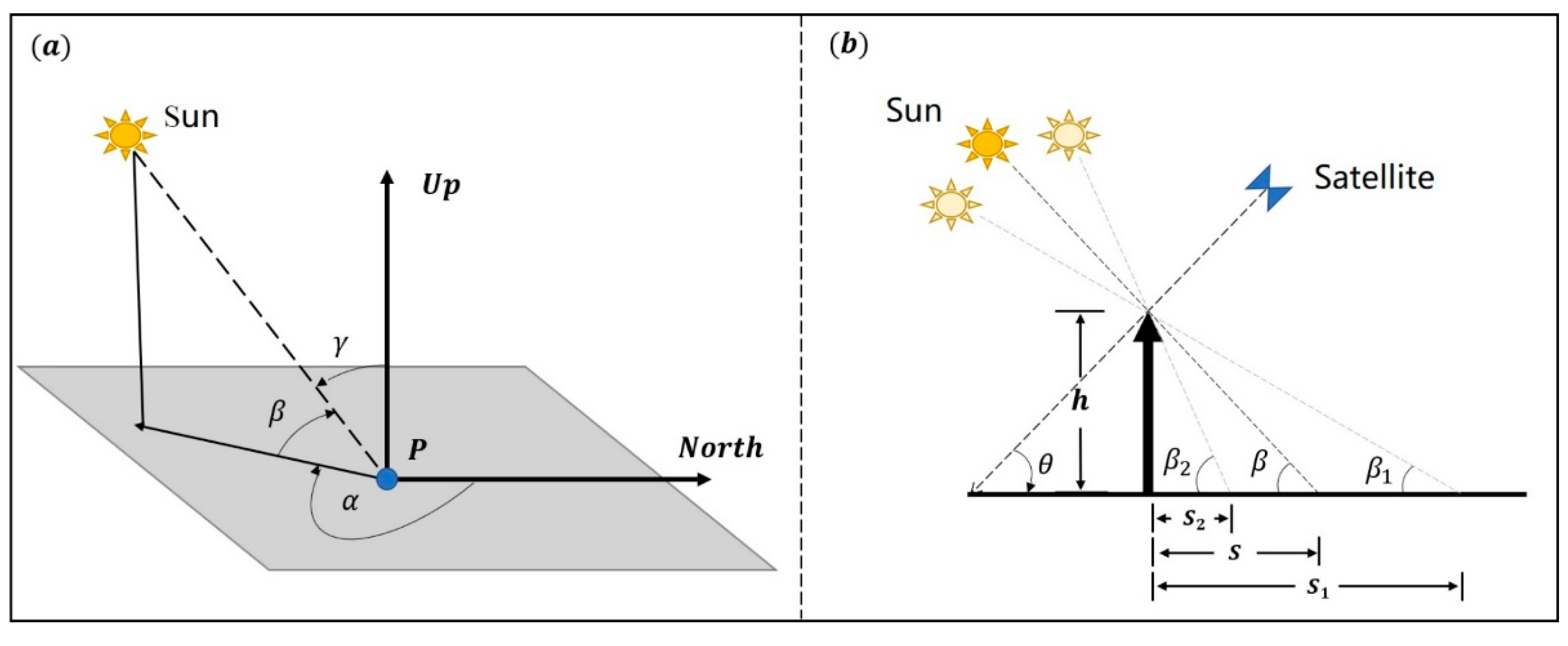
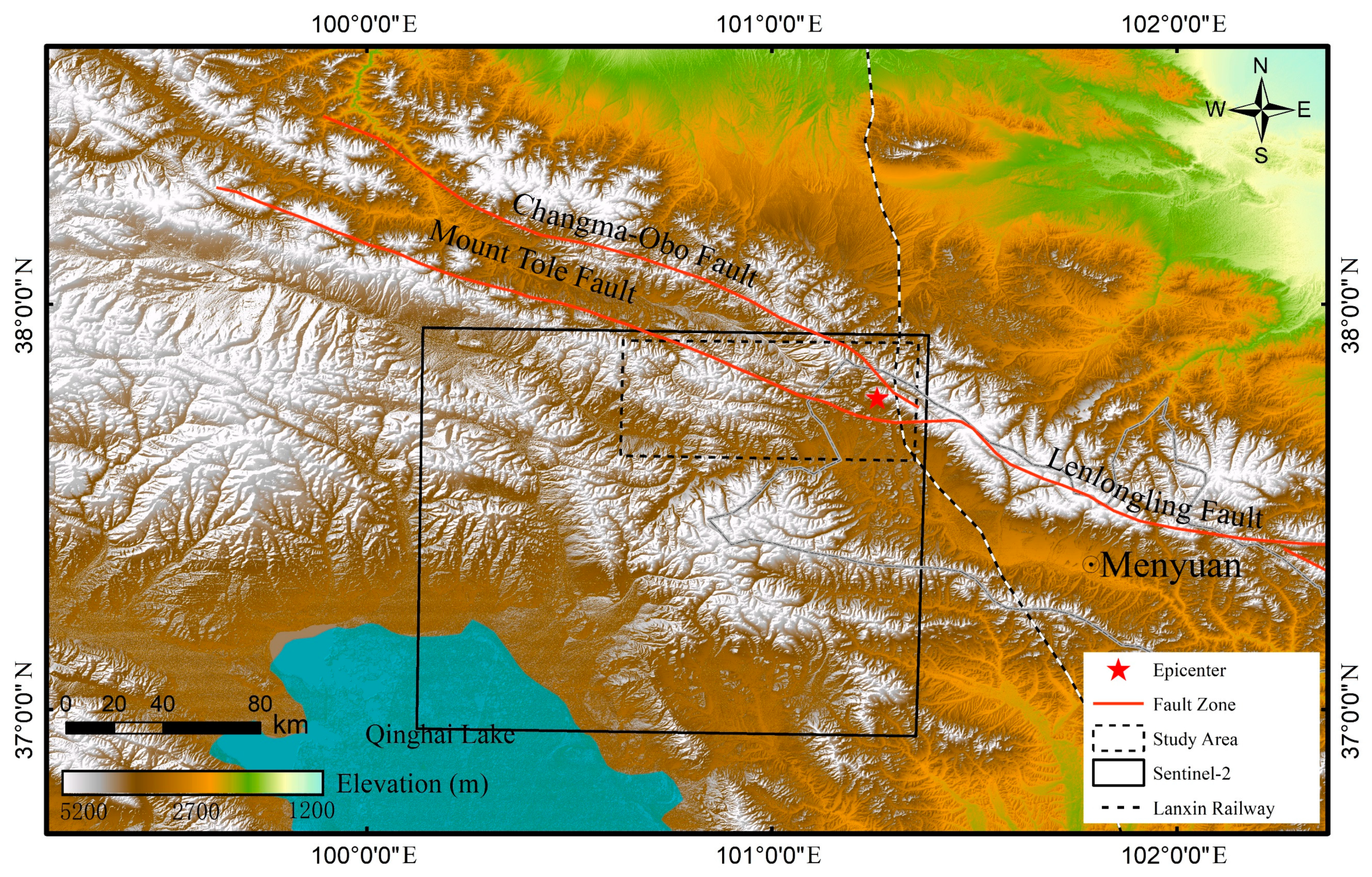
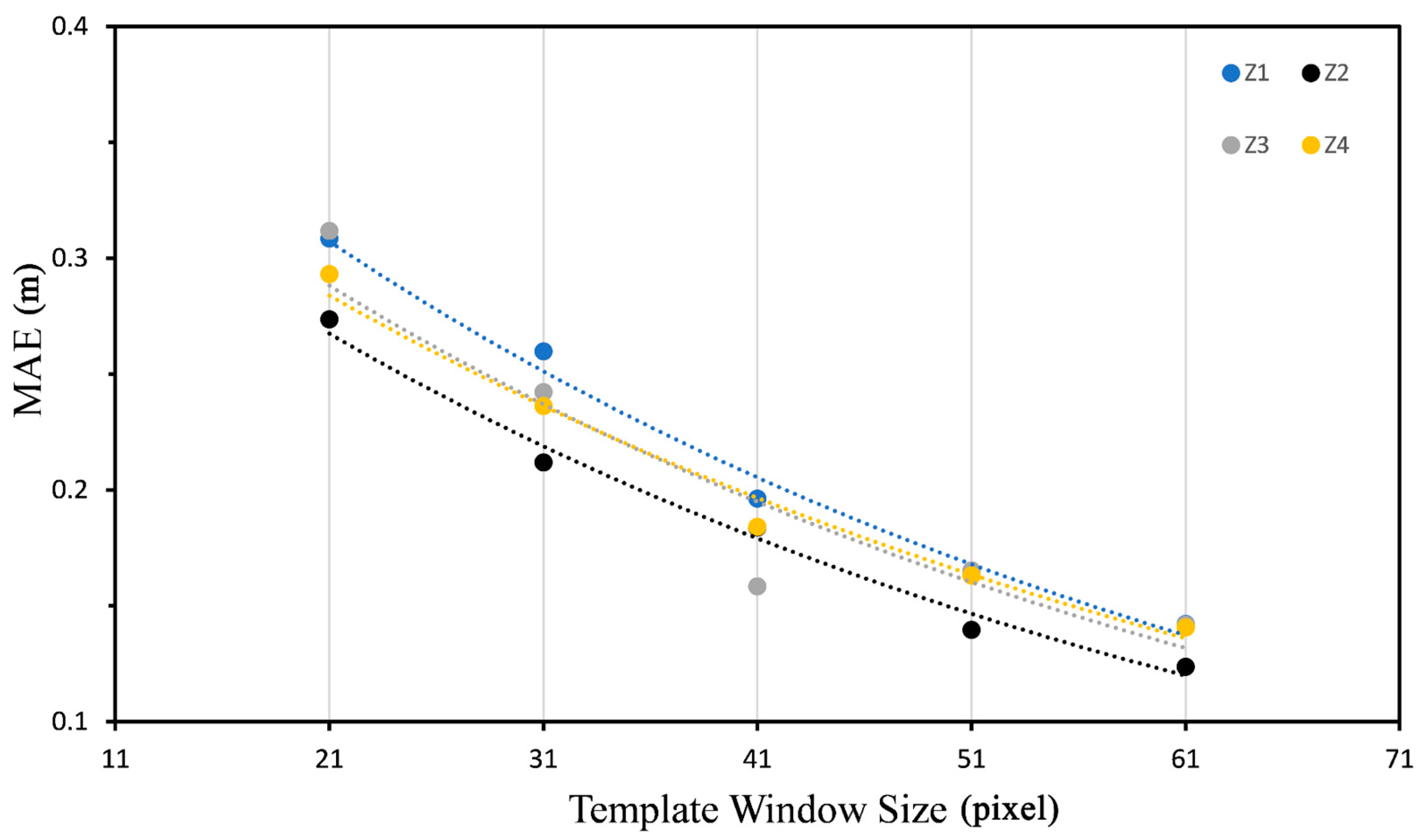
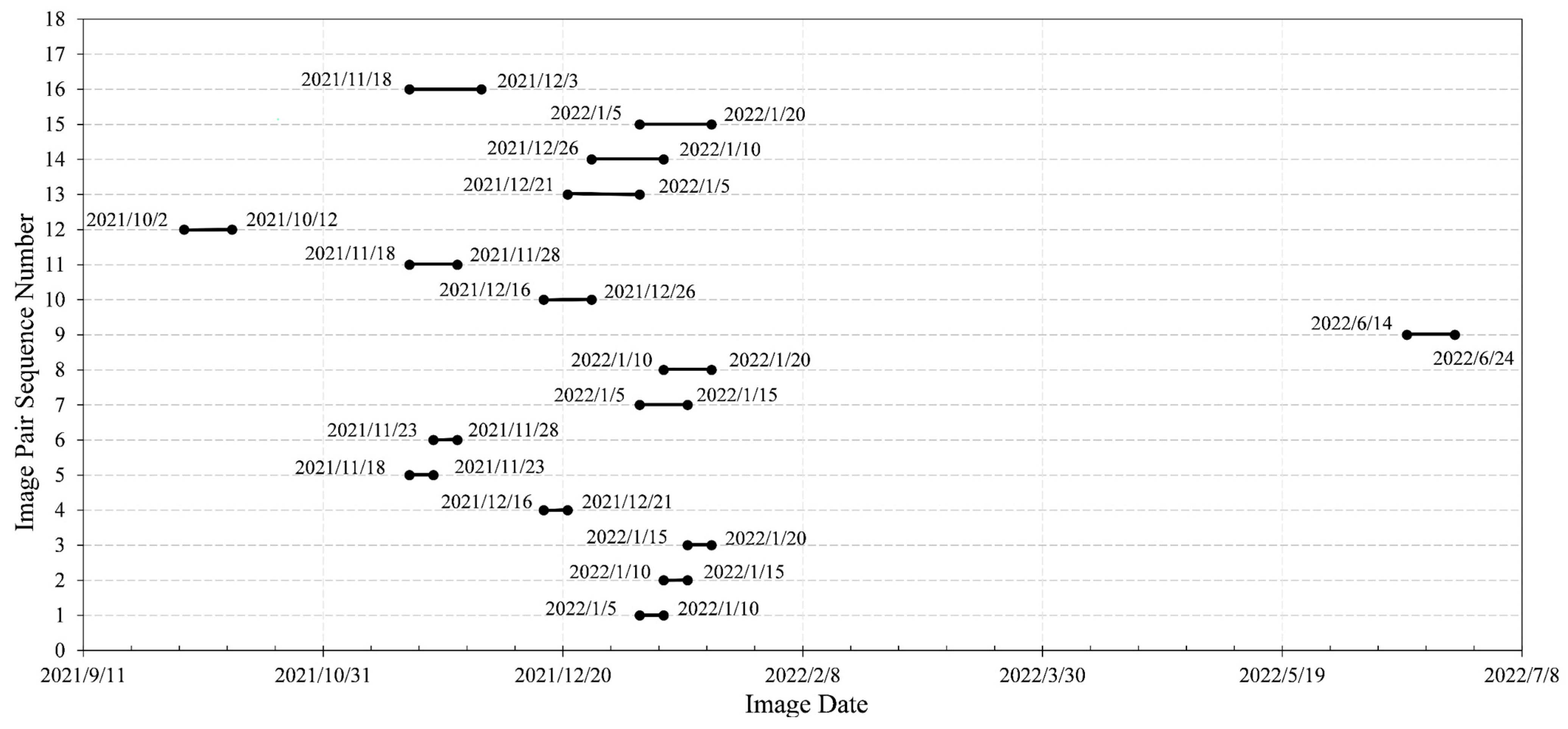

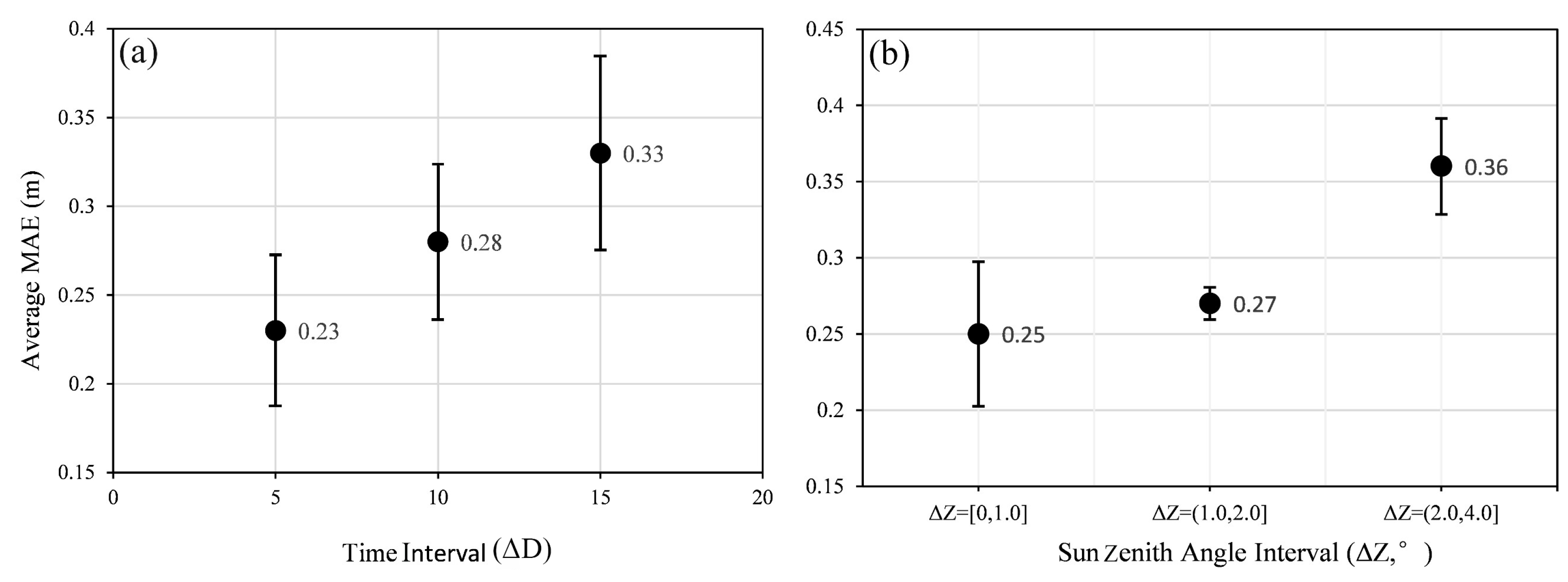
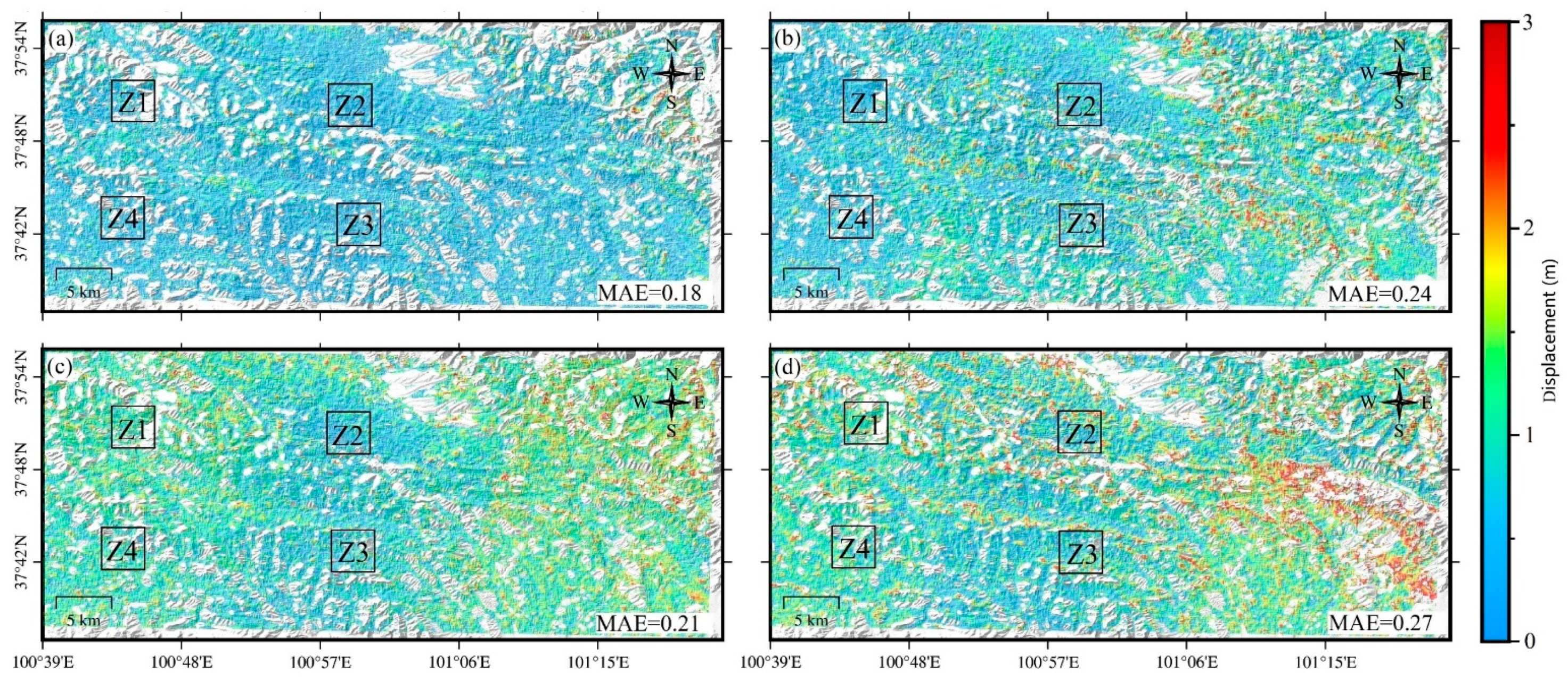
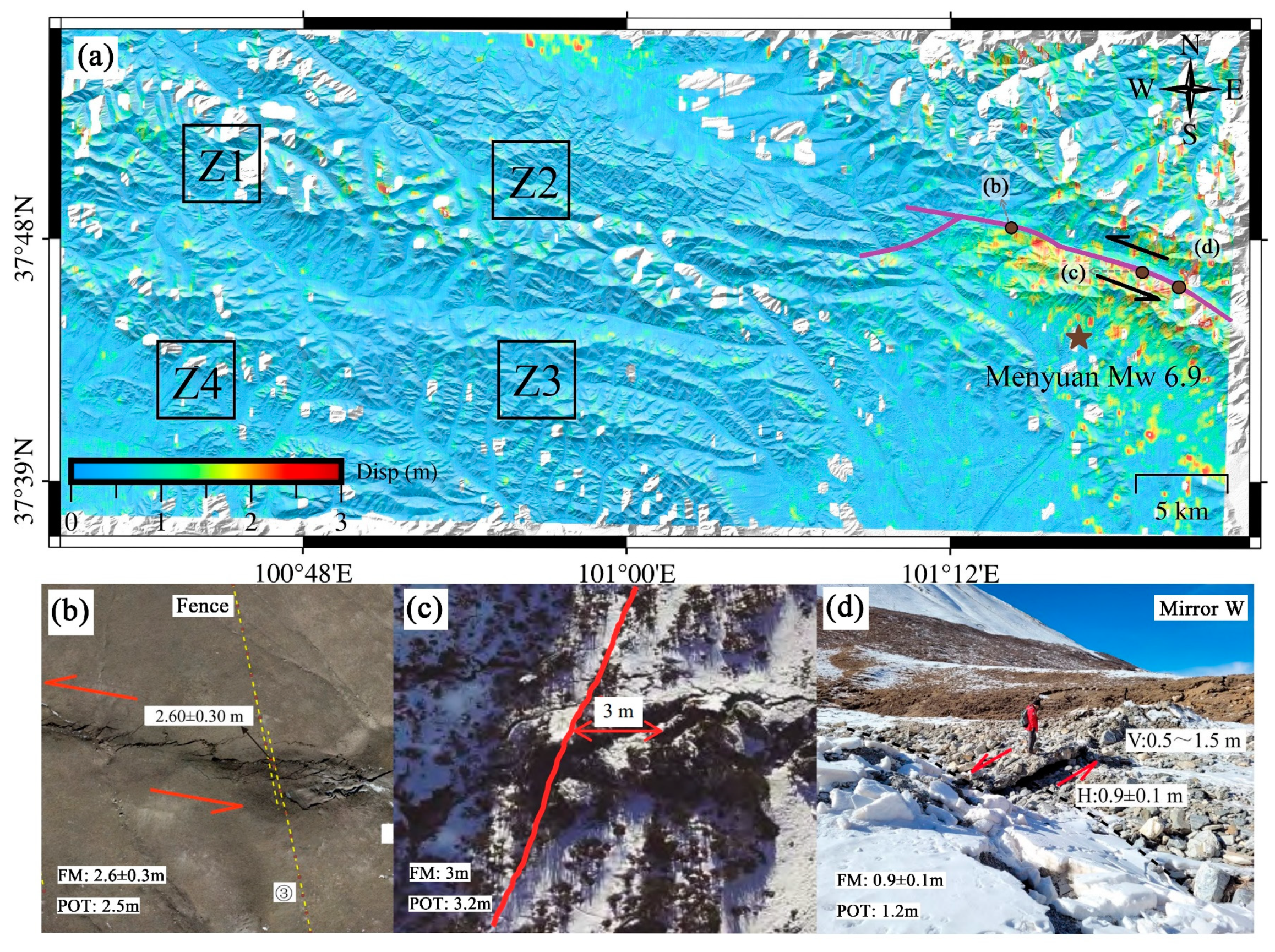
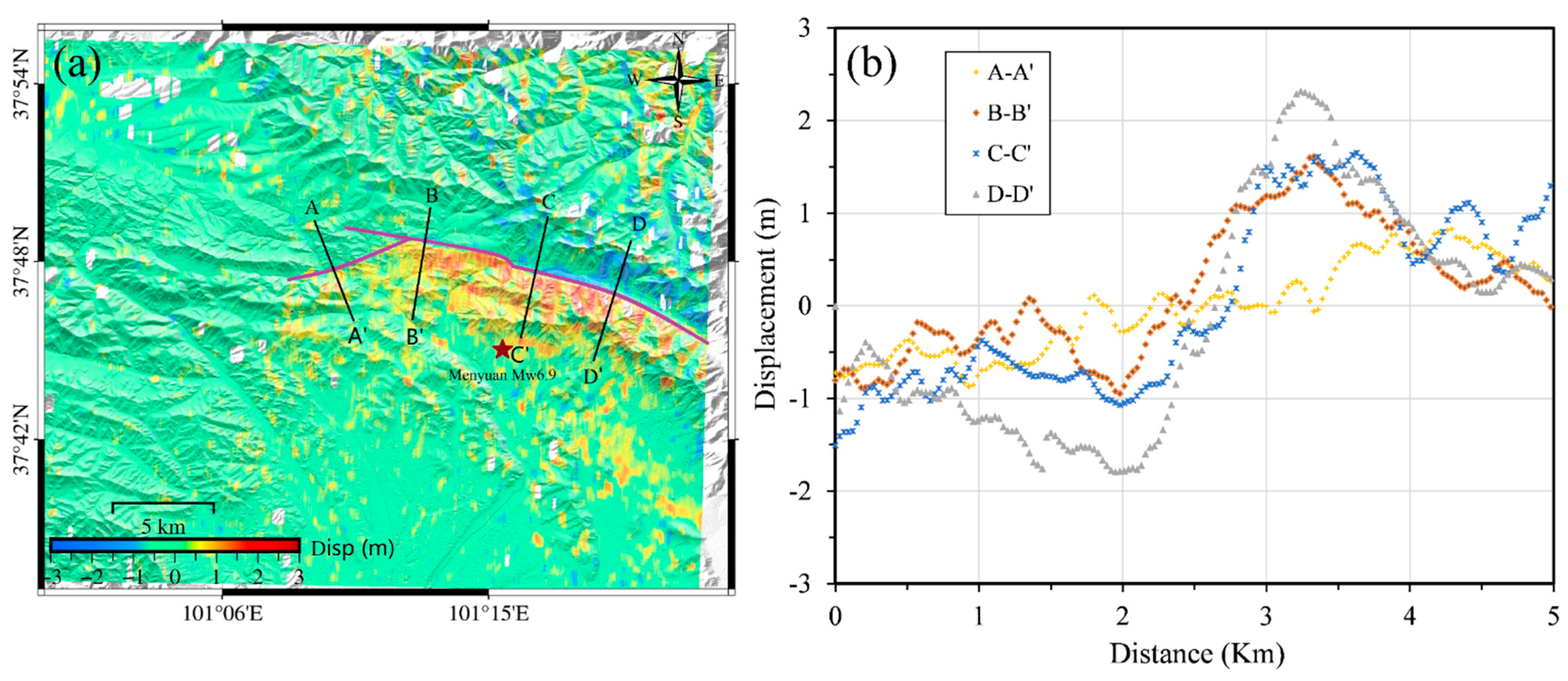
| Number | Date | Mean Solar Zenith Angle (Z, °) | Mean Solar Azimuth Angle (A, °) |
|---|---|---|---|
| 1 | 2021/10/02 | 42.6 | 162.0 |
| 2 | 2021/10/12 | 46.1 | 164.3 |
| 3 | 2021/11/18 | 58.1 | 164.9 |
| 4 | 2021/11/23 | 59.3 | 164.9 |
| 5 | 2021/11/28 | 60.3 | 164.7 |
| 6 | 2021/12/03 | 61.1 | 164.4 |
| 7 | 2021/12/16 | 62.1 | 165.8 |
| 8 | 2021/12/21 | 62.3 | 165.2 |
| 9 | 2021/12/26 | 62.4 | 164.5 |
| 10 | 2022/01/05 | 61.9 | 163.1 |
| 11 | 2022/01/10 | 61.4 | 162.4 |
| 12 | 2022/01/15 | 60.7 | 161.7 |
| 13 | 2022/01/20 | 59.9 | 161.0 |
| 14 | 2022/06/14 | 19.0 | 134.0 |
| 15 | 2022/06/24 | 19.2 | 132.5 |
| MAE | |||||
|---|---|---|---|---|---|
| Image Pair No. | Difference in Solar Zenith Angle (, °) | Time Interval () | Green | Red | NIR Infrared |
| 1 | 0.5 | 5 | 0.21 | 0.18 | 0.18 |
| 2 | 0.7 | 5 | 0.23 | 0.18 | 0.21 |
| 3 | 0.9 | 5 | 0.22 | 0.21 | 0.21 |
| 4 | −0.2 | 5 | 0.30 | 0.26 | 0.24 |
| 5 | −1.2 | 5 | 0.33 | 0.31 | 0.29 |
| 6 | −1.0 | 5 | 0.30 | 0.29 | 0.27 |
| 7 | 1.2 | 10 | 0.25 | 0.24 | 0.26 |
| 8 | 1.5 | 10 | 0.27 | 0.26 | 0.27 |
| 9 | −0.2 | 10 | 0.36 | 0.36 | 0.27 |
| 10 | −0.3 | 10 | 0.38 | 0.35 | 0.28 |
| 11 | −2.6 | 10 | 0.36 | 0.34 | 0.34 |
| 12 | −3.6 | 10 | 0.40 | 0.43 | 0.37 |
| 13 | 0.4 | 15 | 0.37 | 0.27 | 0.27 |
| 14 | 1.0 | 15 | 0.49 | 0.34 | 0.32 |
| 15 | 2.1 | 15 | 0.35 | 0.33 | 0.34 |
| 16 | −3.0 | 15 | 0.45 | 0.45 | 0.40 |
Disclaimer/Publisher’s Note: The statements, opinions and data contained in all publications are solely those of the individual author(s) and contributor(s) and not of MDPI and/or the editor(s). MDPI and/or the editor(s) disclaim responsibility for any injury to people or property resulting from any ideas, methods, instructions or products referred to in the content. |
© 2023 by the authors. Licensee MDPI, Basel, Switzerland. This article is an open access article distributed under the terms and conditions of the Creative Commons Attribution (CC BY) license (https://creativecommons.org/licenses/by/4.0/).
Share and Cite
Wang, X.; Wu, S.; Cai, J.; Liu, G. Optimal Pair Selection Applied to Sentinel-2 Images for Mapping Ground Deformation Using Pixel Offset Tracking: A Case Study of the 2022 Menyuan Earthquake (Mw 6.9), China. Remote Sens. 2023, 15, 4735. https://doi.org/10.3390/rs15194735
Wang X, Wu S, Cai J, Liu G. Optimal Pair Selection Applied to Sentinel-2 Images for Mapping Ground Deformation Using Pixel Offset Tracking: A Case Study of the 2022 Menyuan Earthquake (Mw 6.9), China. Remote Sensing. 2023; 15(19):4735. https://doi.org/10.3390/rs15194735
Chicago/Turabian StyleWang, Xiaowen, Siqi Wu, Jiaxin Cai, and Guoxiang Liu. 2023. "Optimal Pair Selection Applied to Sentinel-2 Images for Mapping Ground Deformation Using Pixel Offset Tracking: A Case Study of the 2022 Menyuan Earthquake (Mw 6.9), China" Remote Sensing 15, no. 19: 4735. https://doi.org/10.3390/rs15194735








